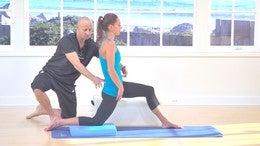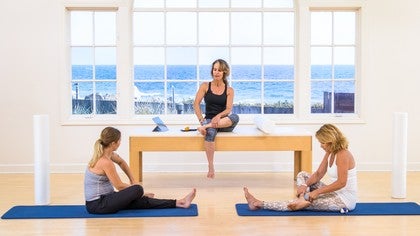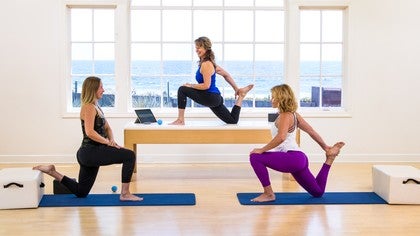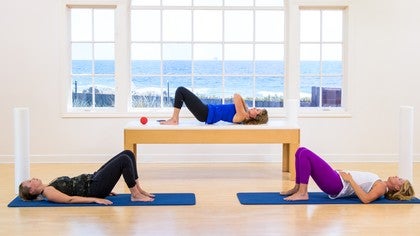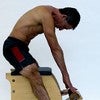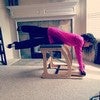Description
About This Video
Transcript
Read Full Transcript
Hi, I'm Miriam Kane. Thank you so much for joining me. We're going to be talking about the joy of running and how we can rekindle that if we've lost it due to some injuries or maybe discomforts. I Have Danielle and Mandy here with me and we're going to enjoy sharing some tools with you to make this happen. First of all, we really were designed to move and I believe we were born to run. The only difference, uh, well there's, there's big difference between our ancestors and ourselves. They ran to find food or to prevent themselves from being food and we run more for joy or for meditation and relaxation or to get from the grocery store to the car. But regardless, we should be able to do that without any injury because of the way that we were designed.
We are going to be talking about how all of this applies to the foot and ankle complex. I hope you had a chance to take the mat class that was designed for runners and if you haven't, you still have a chance to do so. But regardless, we were addressing three non-negotiables. The fact that we need mobility and we need stability and that we need strength for efficient and healthy movement. If we don't have these things, we tend to run for ice and end ceds and perhaps I'm off to the doctor and there are some things that we can do, um, to prevent that from happening and says an ice. By the way, if you still do that, you may want to look that up. Um, it, there's enough research there to show that that wonderful ice that does numb pain also slows down our healing process. So just something to look at. Homework is really important. What we're going to cover, please do it. Do 10 minutes a day at least for a week and you'll be able to see a big difference. Um, I see a huge difference from the clients that actually do their homework.
And then if we just focus, we're not talking about self absorption, but self-awareness, the way that we stand. I'm neutral feet, the way we stand at the ATM, the way that we, um, stand when we're talking to someone, the way that we sit in a chair. All of those become little tiny habits that end up creating the overall picture of our awareness. Okay. And the body is recording this and it becomes the new habits, new neural mapping. So the polities a neutral spine that we enjoy from our [inaudible] practice is something that plays a huge role in our running a practice as well. When we have a neutral spine, the body is able to move with grace and with harmony.
Um, the pelvis, which is the bridge between the upper and lower body, is able to balance the upper body on the lower and the feet if they're doing what they're supposed to be doing, are not going to create as much effect epic, kinetic chain. And also having neutral, a neutral spine creates a type of column, if you will. And if we are a column and we lean, we don't collapse in our lean. And if we don't lean, we end up fighting gravity when we run. It's not a big lean and we'll talk about that a little bit more, but just a little lean, um, allows us to harness the power of gravity instead of fighting it. Okay.
So what is run and running is really flight for about 60 to 70% of the active running, which is pretty cool. Um, we spend 30 to 40% of the time on one leg and the rest of the time in flight it begins in the gait cycle when the foot hits the ground at the beginning of our gates cycle. And when that foot hits the ground again, that's the end of that one gate cycle. And we go through the foot striking the ground, the midfoot cadence or mid-foot stance, excuse me, where you're standing and you have your full body weight times two and a half to three on that foot. So it's very important, um, what that alignment looks like with those mechanics look like. And then we go through the flight stage and the push off for the toe off where we harnessed some free energy. And we'll talk about that in just a moment. If we don't have a great setup to begin with, we're set up for um, well not for success, let's just put it that way. And we tend to deal with chronic wear and tear when we have that and that's where you accumulate that history and it becomes chronic injuries or just a major injury which we're going to prevent here. Um, there are three rockers that you go through in the gait cycle.
The ankle has to have enough Dorsey flection. We have to be able to roll through the mid foot and the big toe and we'll assess that in just a moment. If we think of, before we go onto that, the anatomy of the foot, I think most of us, um, know that we have a heel and that is not what we want to strike on. We actually want to land when we're walking and running closer to the midfoot, if not the midfoot. Some people even further forward than that. It helps to absorb that, um, that rebound that we get from the earth. When we strike. Um, we have the midfoot which creates the arch of the foot, um, some really nice solid bones.
And then we have the metatarsal and the Phalanges that create our toes. And with all of those bones and arches, it's just amazing to think that one toe in particular does 85% of the foot's work and that's the big toe. So let's take a look at that. Okay. And I say running free because there is a certain amount of free energy, uh, a huge amount, let's say 35 to 50%. Um, I didn't do that study, but many other studies that were done to prove that through the windlass mechanism. It's an elastic recoil. If you think about your Plantar Fascia and your big toe working as a rubber band for you, just that springs, you forward 35% free energy.
If I only have this much, I don't have much to go. If I pull back and I let it go, I can travel a good bet. And that is this natural recoil. When you pull back, when you go through the final stretch, if you will, when the leg is behind us, as we're rolling through the big toe, you're the arch of your foot, the Plantar Fascia, the big toe, the Achilles, which you could hold up a small car with the Achilles. That guy is very strong, six inches of tendon has stored up so much energy that it propels you forward naturally. 35 to percent of 50% of the work. Can I say that enough is done by this little mechanism. So it's important to have that range of motion. Okay. Um, we talked a little bit earlier about the three non-negotiables, the mobility, because if we can't pull the rubber band back, the rubber band isn't going to be able to go forward. The stability, which is really our launching pad and um, the stable stability of the foot.
If we don't have it, let's say the instability of the foot would be felt all the way up that kinetic chain. So that's important to have. And then the power, which is the free energy we just discussed for what we call elastic recoil. And that also takes place in the pelvis that takes place in the shoulder. And we'll talk about that in later tutorials. But for now, let's assess. So we took the class and some of US might've noticed that we had some challenges, um, with balance. I know when I first started doing this, I did, um, we're going to check that in just a moment, but first we're going to check the range of motion at the ankle. So Danielle, my daughter, who was six months pregnant and my different Mandy, um, are, um, here. And what they're going to do is they're going to bring their feet directly or 90 degree angle, let's say at the ankle and a 90 degree angle at the knee. Okay?
And they're going, uh, as a matter of fact, sit back on the box. So you have a place to move forward from. So you can do this at home in a chair. So we need about 25, um, decrees of Dorsi flexion to be able to get that rebound. We want that free energy, right? I mean, no sense of working harder than we need to. So what we're gonna do is we're gonna slide forward until the knees hopefully can come just above slightly forward that big toe, slightly four would be great without the heel lifting up. Okay.
And then if we can do that, and I think both of these lovelies are able to do that in a great way. And if we're not, it's no big deal. No judgment. There's things that we can do to work on this. If we can do that, we're happy you're going to stay there so you can bring your foot back. Actually Mandy, so you've got your foot. Yeah. Your big toe under your knee. Kind of explain that a little bit better to you. I hope you've got that.
You've got your knee that can go right over your big toe. And then in that position, when you've got the Achilles under stretch, you're going to reach down and you're gonna grab your big toe and you're can see if you can pull it up about 30 degrees, 30 degrees of Dorsey flection for the big toe. Do we have 30 degrees for the big toe? Okay. So hopefully so without lifting the ball of the foot. Now, if we don't, okay, now what do we do? Well, we can change that and we're going to do that with some soft tissue mobilization. Before we do that, however, we're going to stand up and we're going to work, uh, just to assess the stability of the foot as well. So if you love lovelies will stand up as well.
And we did this in the mat class and what I want you to think about is just creating that column or that neutral alignment. Your feet are facing forward just as you practice from now on, having neutral feet when you walk or stand. And then we're going to have a slight external rotation at the top of the Femur so that we feel that connection. And when you do that, you should feel your arch wake up as well. Right? Okay. And then we're standing tall, but of course, and then we're just not, we're going to avoid shifting. We're going to ask glute need to show up for that.
And we're just going to lift one leg up. Any leg will work and we're going to balance. And so what we would like to think is that we can stay like this for a minimum of 30 seconds. And this is just homework. I have my clients brushing their teeth. I think they're doing that. I can tell the ones that aren't 30 seconds on one foot 30 on the other.
What I want you to pay attention to is if your foot flexes up, if a Dorsey flexes, that's your quad and your anterior tib trying to cheat a little bit for your stability. So be aware of that. And down at the bottom, big toe should be pressing down. I've got you. We're about to do that. Anyways, we're going to put that foot down. So just a little assessment for yourself and great homework and then we'll try the other leg as well. So again, you're going to set yourself up for success. Your feet are parallel, they're neutral, slightly externally rotated, and we float the other leg up and we just hold it right here. So if we were testing our hip flexor, we would bring it up to 120 degrees. We might as well, because we should have that range of motion in the hip flexors as well. Beautiful. Keep pressing through the big toe. If you fell over, be not concerned. I've done that many times. Bring it all the way back down, but just keep practicing. Okay.
And so what we're going to do now is we're going to grab some tools. Um, if you have a mat handy, um, and then we will take, get a Lacrosse ball or a tennis ball. Maybe something harder if you're used to some soft tissue mobilization. And if you have a soft little ball like this, we are using hacky sacks today, then I would encourage you to grab something like this. And if not, it could be just a little washcloth that you've balled up or a sock or whatever you can find. Okay, let's do that. So let's grab our lacrosse balls. Um, we can grab the Lacrosse ball or you can use a tennis ball. Something that's softer. We did this in the math class.
We're going to repeat it again right now. Bringing the ball right here between the ankles and we're just going to go right to the heel and press in and just go side to side. It's as if you're kind of squashing a bug. Okay. Sorry. Bugs. And then you're going to bring the ball in front of your foot and you're going to go across. So the heel is down for this and we're going across the foot like a windshield wiper. And I really like this. I'm my clients typically. And my students come in a good 10 to 15 minutes prior to a session for soft tissue mobilization. They know what their body needs, it pushes fluids through the soft tissue, it and sticks surfaces that are not gliding.
And then we're just going to floss through going across or I'm sorry, going down from the metatarsal all the way to the heel. We're not flossing anything yet, but we will. And then we're going to scribble.
And then when you get into that medial arch, it's kind of like a little trampoline. Guys supposed to have a good bit of energy in there. So if it's just tight, if you're familiar with Tom Ayers and anatomy train, some really great stuff to look at. You know that superficial backline, um, the Fascia runs from underneath of our toes. We're gonna switch feet with you and do the same thing with the heel of the other foot and it runs, becomes the Plantar Fascia, goes from underneath of our toes, um, becomes the Achilles tendon on wraps around the calves and tendons behind the knees and the hamstrings all the way up to the brow. So you could actually have a Fascia that's tied under your foot that could give you a headache. So good to address.
And we're going to bring the heel down and we're gonna go across. So here again, just notice that there's spots that are tender
We're going to put the ball away and then we're just going to have a seat. So if you ladies want to just grab a seat and we're gonna have a leg figure forward across the other leg. And so if you take your thumbs, and if you haven't done this before, this might be a little surprising. So just giving you a heads up, you're going to take your thumbs and you're going to go to this big old bone, the Tibia, and you're going to slide your thumbs in and under the Tibia, and you're just going to hold right here. And you're going to bend and extend Dorsey flection of your ankle. So you're flossing.
And then you're going to walk down another inch and you might find something a little bit different and walked down a little bit more. So this is where, um, some of the big toe muscles with a couple big toe muscles live and they, there can be gremlins in there. So bend extend as you continue walking down, I can get really interesting. Yeah, found a spot, Mandy. Yeah. So it might hurt, but as you come back down or just be very uncomfortable, um, and up and down, but you're untangling some muscle fibers that are really important. If you think about that big toe you want it to do, it's 85% of work and we continue down, up and down, all the way down to the ankle. And again, we're going a little faster than I would normally encourage you to go give yourself the time and down. This is just self care stuff. That is amazing. We need that glide and down. Good.
So we come all the way down and you have a ball. If you have a sticky ball, like a lacrosse ball or there's some other balls that have a little more stick, you can actually get behind this ankle bone and you can just kinda twist behind. And if you have areas that are a little sticky, you just mobilizing some soft tissue. A lot of these tissues, think of the times we've had ankle sprains and bumped the ankle. And I don't think I've ever met a runner that hasn't jammed an ankle. Okay. So just mobilizing this tissue a bet. Okay, wonderful. So we're going to put that ball down and we're going to move on to the other leg, crossing it over and bringing our thumbs up near the knee and drawing the thumbs down and really pressing in. Don't be shy about this.
And then we're going to bend and extend. So you're flexing plants are flexing, Dorsi flexing and walking those thumbs down looking for any points of interest.
If you have to sit at a desk, hopefully you get to stand up. But if you do have to sit at a desk, this is something you could do at your desk. And then we'll take that ball and we'll just see what we can find over here as well. And so we're just twisting and you're pressing in and trying to just twisting and to see if there's anything that feels a little sticky
Good. Yay. All right,
So we'll come up to a kneeling position first of all, right on the roller and we're going to bring your hands forward. We go back to our quadro pad and we're going to, let's pick the lake closest to the ocean and we're gonna rest on the outside of the Shin and bring the other leg on top. This is extra homework for the ABS. Okay. And now we're going to roll it in and back out and roll it in and back out and roll in and back so you can bring it all the way into your ankle. Taking your time and back and back.
Nice. We'll do a couple more and hopefully you're finding some little spots. And then you're going to stay probably around the center. You're just going to go side to side a little bit. Let's see if you can find something, maybe really bring your body weight into it and spend a little time just mashing into that soft tissue. All right, wonderful. So we'll come back down to the toes. Do we find some points of interest there?
Okay. The break of sweat on our, we get the other leg, so we're gonna come back forward again and we're gonna put the body weight on the outside of that leg shift in and we're going to bring it in and out. So again, drawing the abdominals in, getting ourselves a little bit of extra credit for the core, pressing the arms down. Good form on this as well. So we're just rolling it now. We don't get any points for speed. Slow down to where you feel that there's something that might be of interest. I think we'll all find something there and then you're just going to go side to side mashing into it. Trying to release a little bit and taking mental notes that we'll go back to that beautiful and bring it all the way back. Nice. How was that?
Okay, I think that was great. That's just a little bit of soft tissue mobilization that we can use. Thank for the feet and for the anterior Tibialis Posterior Tibialis. Um, now we're going to go to the calves. Uh, we have the soleus and the gas drop and we're going to put those guys up on this roller as well. It's a little bit more pinpoint on the Lacrosse ball, so that can be your choice. But I feel like we can feel this pretty well up here.
So we're going to take one leg, we're going to put it down and then we're going to cross the other leg on top. We have a little bit of extra weight and first we'll kind of go side to side. And so we're going to start right in the ball of the gas drop so you guys can move yes. Into. Yeah. So we're already anticipating, we bring the arms forward and bring yourself a little bit further forward and then we roll a little bit more. And then if you can lift your bottom and start to roll the outside lateral of the calf. I know, I know I'm right with Ya. And then what we can add is a little bit of flossing for added enjoyment, the bending and the flexing and bending and flexing, going a little bit to the inside to really trying to hit the medial, the back, the lateral, and then we can stay on a spot of interest.
And you can even just press down and the harder the roller rumble rollers [inaudible] yeah, right.
I haven't met anyone symmetrical yet, but um, we work towards that. We work towards that. And so if one side is working harder or one side has had an injury and it's a little gloomy, we're going side to side and just really try to find a spot and Preston you might be surprised. Um, then that side might need a little extra left, which then brings us to flexibility. And so in today's environment where we have so much technology to really measure things, um, something that we're learning. And thank you ladies, is that, do we really need to stretch? Um, I know when I started in, in fitness, we were stretching everything, but as we showed with the rubber band, you need a certain amount. We all need a certain amount of tension and the connective tissue and the tendons and the muscles in order to have that free energy.
So as long as we have the range of motion and this is what I understand to be true, when you can do your research as well. Um, as long as you have enough range of motion for that movement to occur and a joint, then do you, maybe you don't need to be stretching that muscle. If this little guy was really, really stretched out and I let him go, I think you already can visualize what would happen. It wouldn't really go anywhere. Okay? So that's that with flexibility. Having said that, when we do know that something needs to be stretched, that it doesn't have the range of motion, then we want to do so. And so we can come up into an up stretch. And again, my dear friend Anthony Let, um, has with the innovations really focused a lot on the contract and relax, um, aspect or way of stretching. And I like that a lot.
So just very simply in this upstretched position, we're already getting a stretch. Would you guys agree? Okay, so we're gonna think nice and long from the fingertips all the way up to the sip bone. And then we're slightly gonna bend the knees, but then we're going to lift the sit bones even higher. So we're feeling a hamstring stretch, but we're also stretching the soleus and the soleus shares half of the Achilles tendon with the guests anemias, but he doesn't get top billing, not quite like the gastro anemia. So we need to pay attention to him too. And then we're going to take, we're gonna stay on, let's say the left foot and we're going to add weight by putting the right leg around the left. We're gonna wrap that foot around the other just to add a little bit of weight. And we're going to bend the knee a little bit more for just a moment.
Take a couple deep breaths, exhale and one try to lift your sit bones a little higher. And we're going to press down now with the ball of the foot. This is still at the knees, slightly bent. We're still focused on Mr Soleus here. And then we're just going to stop doing that and drop the heel a little further and then try to extend the knee a little bit more.
And so now trying to extend that need to get into the gastrocnemius. And if we can't, if this is not going to happen because of the hamstrings, then we can certainly do this standing on a step and we pressed the ball of the foot into the mat, give it two deep breaths and then one, and then release and drop the heel. Nice. And then let's switch legs again. Regroup, lift. That's those. The bones up in the air dropped the way to the head so that the ears frame the arms and we're going to leave the body weight on the right leg and just slightly bend the knee. And you may already feel a stretch and you may not need a stretch.
Remember this is if you need the stretch, you're going to press down with the ball of the foot, give it two breaths and stop pressing down. Instead, try to drop the heel. And now let's see if we can extend the knee for the gastrocnemius. And we pressed the ball down again for two and one and release. Nicely done. And let's bring those feet parallel and let's lift the heels. And just bring ourselves forward on her knees.
So we're on the balls of the feet and now we're going to walk back this way. So this doesn't make everyone happy, especially if you don't really have the range at your toes. Okay? But as we were saying earlier, that range is very, very important. So I want you to see if that bothers you. And if this is something, especially if you're doing reformer work where you are kneeling and you have your foot against the shoulder blocks, this is really a great position to be in and this would be a great way to stretch those toes up. And then we're going to bring ourselves forward and we're going to check the range here. This would be a simple way to just sit.
And by practicing sitting here, we're stretching the front of the Shin or the anterior Tibialis, the front of that ankle and areas that if they're tight are going to impede or Dorsey flection as well. And what we could do is even come back a little. And of course you're doing all of this with gradual progression. You're not just forcing. And we could try to lift the knees or lift one knee up, even. It'll stretch there and bring it down slowly and then test drive it with the other leg and bring it down. Nice. And bring it all the way back up. Wonderful.
So we talked about this earlier, the three non-negotiables of mobility, stability and strength. And then how do we develop the strength? Well, the standing foot work I'm doing our calf raises are a great way to develop the strength of the calf. Um, jump roping is a great way to develop the strength of the calf, which is very similar to running that little spring effect. And then we have the foot. So I have a little hacky stack here and you ladies have little hacky stacks there. And so we're just going to test drive this and we're going to come down to, or I'm going to come down. You're going to stand up and if you have something at home that, it doesn't have to be anything fancy, right? It just has to be something that you could grasp with your toes. You're going to grab this.
We're going to bring this hacky sack down and we're going to try to grab it wrapping. We're going to put the ball of the foot over top of it, and we're going to wrap those toes around that hacky sack. And then we're going to try to lift it. Yep. All right. And then we're going to put it down and then we're going to go back over here and we're gonna pick it up. Oh, and we're gonna pick it up. Yup. Good job. And we're going to bring it back down.
And so this is something that we could do. You could just have little hacky at your desk or at work or at home, and you just pick the hacky sack up and you put it down, you wrap those toes around it, really give it a good hug. Feel that arch working on lift. And you could actually brush your teeth like this. So about that 24 seven homework and bring it back down.
It's just the little things that we can feed in. Let's try the other leg and see if it has the same potential. I'm sure it does, but let's see if it does today and we're gonna wrap those toes around and we're going to lift it up. I can feel it's a little harder on this side. You two and your Rockstar, bring it back down. Yeah. Easier for you. And then we're going to bring it out and again, we're going to wrap the ball, the foot, the toes around it and bring it back up. And we can use this as balance work as well.
So why would we have gradual progression and just about any other movement? Um, if we are playing baseball or if we're playing soccer, we learn what we need for performance. If we're running, oftentimes we learn what we need for performance to go faster, but we don't really think about pulling all the components together to be able to run efficiently and without injury. And these are some tools that if we pull all these together, you'll find that you're becoming more mobile where you weren't and we're stable where you need to be and you'll find more power. Okay. Wonderful. Thank you. And now we're just going to kind of, just to recap, we talked about this three non-negotiables and I would say, um, your homework is absolutely critical. It's great to know this stuff, but what do we do with that? So learn how to feed this into your day. Where can I take 10 minutes at the end of my day or at the beginning of my day or as I'm brushing my teeth, like I was saying, or if I'm in the kitchen and I'm sautéing that I'm sautéing on e ffoot and pressing my big toe down, things of that nature.
Another really great way to make sure that you're walking and running correctly is, um, really simple and it's called going barefoot. Um, e oof the things that I do with my Alfresco boot camp girls, we do this twice a week where we go outside and we test drive. What we learned in the studio is we take our shoes off and we do this quite often and it's not even on a soft surface. And so as soon as we take our shoes off and we start to running the running process, I start to hear out and then it gets really quiet. And then there's no more owl. And that is because we innately know what we need. It's just that we've made our feet a little stupid.
We've put them in these shoes and they can't feel we've turned off that sensory feedback. And so we continue doing all right. And so what will we have done is created shoes that would, um, not that we were, we wouldn't feel pain. And so yeah, we don't feel pain maybe per se, but it still goes up that kinetic chain and creates other problems and, um, that just doesn't work so well. So I hope that you'll be able to use these tools. Um, we're, I do want to say e oother thing and that is too, I didn't address the knee and the knee is a very, very important middle child. Um, it's between, it stands between the ankle and the hip and oftentimes, if not, most of the time knee issues are actually ankle, foot or hip issues. And we'll address more about the hip issues and an upcoming tutorial.
I hope you can join me. Um, but for today, let me just say that if you do have knee pain, since we're not taught, we haven't talked about it much today, which you can do is address the tightness that's occurring probably above your knee and below your knee. And that'll give your knees some slack. So the soft tissue mobilization that we did for the calf for the anterior Tib, we're also going to be doing soft tissue mobilization above the knee. So I hope you can join me and thank you.
Running with Pilates: Running Free
Comments
I will certainly be doing my homework!
You need to be a subscriber to post a comment.
Please Log In or Create an Account to start your free trial.
